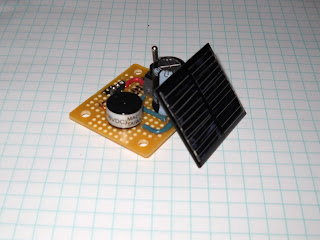So, after the first big buying spree, and my foldout table begame a tried and true hobby center, complete with solderin iron, hot glue gun, 100 watt desk light, etc. I dug right in on learning about diodes, capacitors, transistor, etc, with another book I got: Getting started in Electronics:
http://www.solarbotics.com/product/11350/
I already had a good fundamental knowledge of electricity (I am an Electrician by trade, afterall), but knew little to nothing about electronics. This book helped tons. For instance, I already knew things on DC needed power and a ground, and that diodes point a certain way, but what I didnt know was the "pinout" of transistors, what the different types meant, how a capacitor was used, and how it charges and discharges- and at what times., etc.
Breaking out my radioshack breadboard and jumperwires, and the bag of assorted resistors, capacitors, transistors, etc, I began to tinker.
Simple stuff, like putting a NPN transistor in the center, putting power to its Collector, an LED at its Emmiter, and holding a jumper from the Base in my hand.... and figuring out on my own if it needed power or ground to "work".
After figuring things out a bit, and realizing I had a mixed bag of NPN and PNP transistors, and no real cheat-sheet to look up which numbers were which.. I made my first thing: a transistor tester.
I tested it on the breadboard before "hard wiring it permanently. Its basically just 3 pin sockets to take a transistor in front, and a momentary switch that send either power or a ground to the center pin (base). The switch is spring loaded set to power by default, so touching an NPN to the 3 sockets will get me a tone. I could test the transistor by moving the switch- the tone should cease.
To test a PNP, no tone unless I DO hit the switch.
You may notice bit of fancyness going on at the back end. This gizmo got an upgrade recently, as originally it used a battery back of AAAs to run it, And I got tired of replacing them (not from dead batteries, but rather my cannibalizing the battery pack to test/build something ELSE).
So now its Solar/Desk light powered. The big capacitor (4700uf) is for PNP testing- while an NPN will tone constantly off the Solar cell power, a PNP is more demanding (not sure why), so the CAP stays full waiting for the switch to be toggled, and the test will indicate its a PNP with a momentary beep... good enough for me- to have a gizmo that runs off of.. pretty much nothing!
This little Gizmo is one of the few things from my early learning that survived to this day. Mostly because I still use it; whenever I take apart some electronics, harvest the transistors, and want to know what bin to put them in.
My next thing to do was find/build a power supply, that I could wire to my breadboard, and set the power to what I want. I had just learned about a Voltage Regulator chip, like the 7805- that takes whatever power you apply to it, and only lets out 5v... so knew it was pretty straight foreward to do. After surfing the internet for "Variable power supply" schematics, I was happy to see I already had all the parts I needed to build one. After some careful assembly, I now have another neat little Gizmo, I made myself, that, using a 12v wall-wart power supply, can output between .5 and 10v DC.
Here it is, as tiny as my transistor testor (a common theme I seem to have: tiny, solar, and "what I think looks cool"), putting out 3v, as seen on my homemade voltage/amp probe, in the background. The toggle switch between the guages sets which guage the probes are connected to: the switch points to which guage its on.
The power supply has its regulator and rheostat set back at an angle, originally because I wanted to mount this in a small "project case" I got, with an angled front... but it didnt fit, so here it sits, Heat sink supported, and underside solder points lifted off the table top with this neat white stuff: InstaMorph! As seen here its a hard plastic similar to LEGO plastic, but dip it in a pot of hot water (160 degrees), and it turns clear, and has the consistencey of playdough... moldable plastic!!
The stuff is just too cool: http://www.instamorph.com/
Hmm looking at the above photo, I realize it doesnt show just how "what I think is cool" this little sucker is... so lets take a "beauty shot" with no flash.. for a fuzzy but more revealing angle and insight to why turning this thing on still makes me smile:
oh yea!! If it looks like it escaped from a TR0N universe, then its automatically cool in my book! I mean.. why have a boring indicator LED showing that its on, when it could be a SUPER bright blue LED hidden in the works, so it looks like maybe the thing is giving of Cherenkov radiation or something? :)
But I know you are really loking at the utter chaos that is my hobby desk in the background.
So with this basic set of tools to get me going, I started trying to build some of the junkbots out of the Junkbots, Bugbots, Bots on wheels book. [now for my next post I need to find that old symet...hmmm]




No comments:
Post a Comment